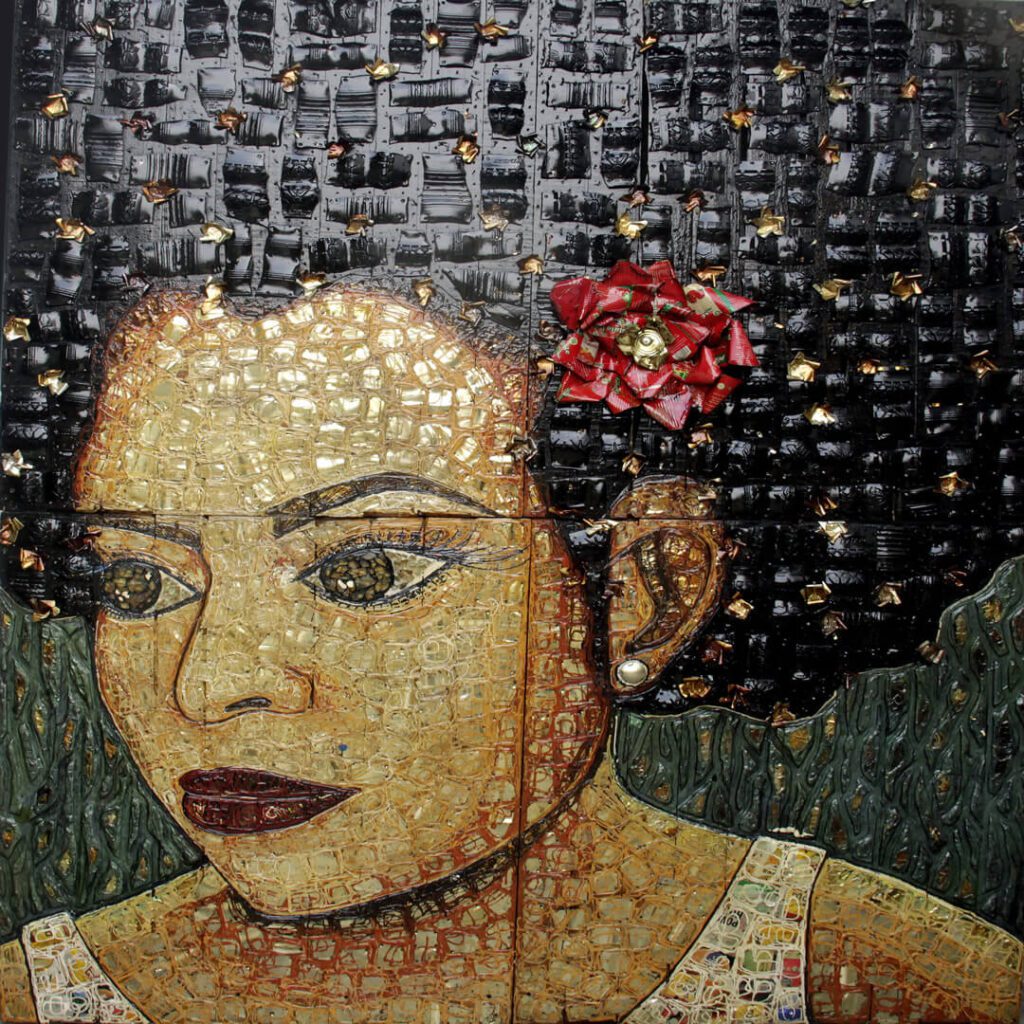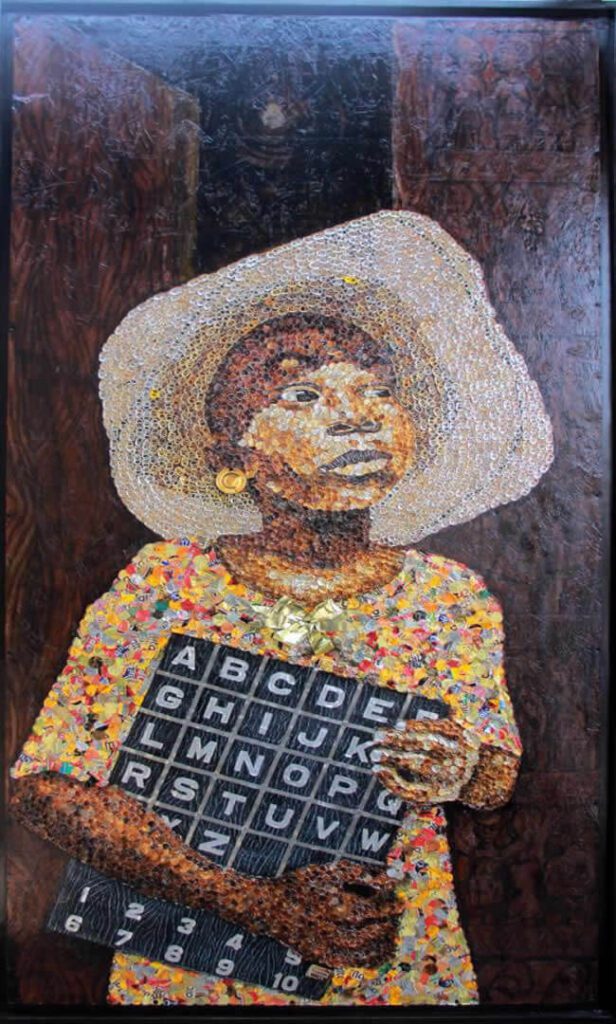The Lagos art circuit continues to evolve in ever more creative ways for self expression and societal impact. Samson Akinnire’s art reclaims the concept of trash and proves that even discarded, seemingly useless material can be channeled into timeless pieces in the right hands. Born and raised in Ajegunle to a family of artists– Samson’s first exposure to the concept of design was his father, who was an architect. His siblings as well carry this creative affinity with them, the eldest being a painter, another one, a gallerist and he (Samson) identifies as a sculptor, although he has flirted with painting in the past.
As a child, he derived pleasure in creating toys with scraps he would find rather than playing with them. When the average child would see an empty drink can and kick it around, Samson will tear it apart, deconstructing the shape and independent colors. Then he’d make his own special shapes out of them. He’d picked abandoned slippers from the street and convert it into a Lorry. “Whenever my mum bought toothpaste, maclean. I will take and punch four holes and tie bottle caps underneath and then turn it into a bus” Samson said. Toys became artworks and Samson began to create in the conventional sense of it– he began to paint, and eventually went to Lagos State Polytechnic to earn a degree in Sculpture.
At the school, techniques that he brought with him from childhood were combined with tertiary education to find a distinct style that is rarely replicated anywhere else in the country. He’d cut softdrink cans and straighten them into thin sheets to create shade and background, Samson would then punch holes into the ‘trash’ and wind copper strips around them to ensure they stay in place. When witnessed from afar, the artworks are imposing, but the genius lies within how each material is manipulated to play a part in a bigger picture. A glitzy mosaic of various elements; a barrage of expression through junk. Waste, coming together to become immeasurable in value– status, and in message.
Samson’s subjects vary across spaces, it might be a notable figure, people he sees in his daily life, other times, these artworks are conduits for his imagination and past experiences. For “Egungun”, Samson reached into his past to portray childhood memories. “When I was in Ajegunle, there was this masquerade that would come out. I was always happy to see the masquerade. We would follow it everywhere it went.”
Samson’s appreciation for women also shines through series like The Gele, and the Brown Skin series. In these works Samson used the insides of various can tops to create portraits. He’d burn the metal to create a burnt or tanned look, depending on what’s needed. These material are stapled in succession across canvases, sometimes on cloth. The subject matter refrains from politics of the earth, rather dealing with immediate experiences and general beauty that lies in waking life. “I can see a woman wearing some kind of glasses, or if she has a beautiful flower in her hair, and I’d draw inspiration from that.

Title-brown skin series
Medium-upcycling materials on board
Size-126cm X 210cm
Year-2022

Title-Rose
Medium-upcycling materials on wooden Pannel
Size-220cm X 200cm
Year-2021
When asked how he gets his material, Samson revealed he used to scavenge the wastelands of Ajegunle looking for whatever excited him. “Along the line,” He added, “I realized I wasn’t getting enough to produce artworks. If I need 50, and I find 20, I wont be able to produce. I started buying from cartpushers.” He eventually created a flyer announcing that he’s ready to buy waste and then got in touch with the people that supply the cartpushers. He also bought a scale to ensure the process is sufficient and everyone got paid. “They bring it to my place and they use it earn a living. I use it as a means to help the environment, and also help them financially.”
Akinnire plays an important in helping the community mitigate its waste problem. Over the years, he has created up to 200 pieces using junk found around Lagos. Lagos in itself has a waste problem, estimates claim the city generates over 13,000 tonnes of trash per day, and in 2018, Lagos Government disputed this claim, saying the real figures far outweigh recorded data. Only 20% of this waste is processed or even stands a chance of being recycled. A lot is released into the sea, burnt, thrown into sewages and sometimes clog drainages that eventually result into flooding.

Title-seeker of knowledge.
Medium-upcycling materials.
Size-134cm X 254cm.
Year-2023

Title-self portrait @ 8years old.
Medium-upcycling materials on canvas.
Size-142cm X 258cm.
Year-2023
However beyond making use of this waste, Samson is redefining the concept of trash– waste– undesirables. “They call me a pangolo artist” he once said in an interview with AllNews Nigeria, he has become known for his craft and seems to enjoy the attention. Samson is assertive with a thick yoruba accent, he stammers on his words slightly, but this stems more from emphasis than selfdoubt. A thick beard and sunglasses plastered on his face like a personal brand. His artworks are painstakingly time consuming, with each piece of tin and waste carefully chosen on the basis of their color and lustre. Every shape is beaten to part, or has other elements constructed around it to augment its presentation and introduce a fresh perspective in how we see it.
Samson Akinnire finds inspiration in what he sees, what he remembers, and what he wants to do. An abandoned car rim becomes a sculpture base, an empty can of tin tomato becomes a flower. The material he finds tell him what to do with them, and in some cases, he will make them flexible to fit his vision. Samson doesn’t shy from beating, punching, cutting, nailing, screwing, gluing, welding and even sewing if necessary to satisfy his conscience.

Title-window to the soul.
Medium-Tapestry, upcycling materials.
Size-230cm X 300cm.
Year-2019
These works, made of material that are thought to be waste has travelled across the world. With appearances in RAM Gallery, New York; PearlLam Gallery, Shanghai; Gemini art Gallery, Lagos; Signature African art Gallery, London; Nike art Gallery, Lagos. These works have also been acquired into notable collections over the years. When viewed from a bird’s eye view, the thought of Akinnire’s journey is inspiring, but what is more striking is metal cans, picked from the streets of Ajegunle receiving the same accord, attention and glitz as the finest paintings of our time. It is all about perspective, really.
Oyedele Alokan is passionate about culture and arts. Engage on instagram and twitter,


